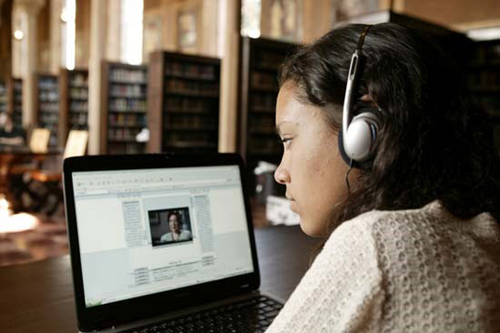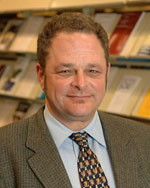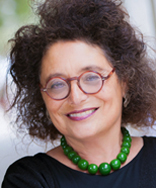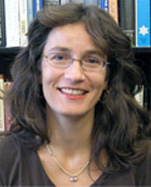
By Donald H. Harrison


SAN DIEGO—Some 20 years ago, Brian Schottlaender was serving as an associate librarian for collection services at UCLA, when Doug Greenberg invited him to visit a movie studio lot in Burbank. Greenberg took him to the trailers which then were housing the interviews that volunteers had videotaped with survivors of the Holocaust under a project funded with proceeds from Steven Spielberg’s 1993 movie Schindler’s List.
Greenberg, who was director of the archives, “showed me around and both he and the project made quite an impression on me,” recalled Schottlaender. “We stayed in touch after I moved to UCSD (where Schottlaender now is UCSD’s university librarian, based at the campus’s Geisel Library) and he to USC, “which now is home to the Visual History Archive of the Shoah Foundation. (Greenberg subsequently moved to Rutgers University.)
At UCSD, Schottlaender met Prof. Deborah Hertz, who had joined the UCSD faculty in 2004 as Wouk Chair of Modern Jewish Studies, and Dean Michael Bernstein, who, when Schottlaender arrived, was serving as UCSD’s Dean for Arts and Humanities and who was, coincidentally, a university classmate of Greenberg’s.
“I became convinced that we had to have access to the Archive for our students and faculty,” Schottlaender said. “I reached out to Doug and told him that UCSD wanted to license access to the Archive in order to launch our Holocaust Living History Workshop.”
Over the years Spielberg’s volunteers had collected more than 50,000 interviews in over 30 languages. Thanks to a collaboration between the Geisel Library and UCSD’s Judaic Studies Program – recently renamed as the Jewish Studies Program – a license at $15,000 per year was agreed to, enabling these interviews, which have been indexed by key words, to be downloaded onto UCSD computers from the Archive at the USC Shoah Foundation.
In 2010, Susanne Hillman, PhD, was hired to serve as the coordinator of the Holocaust Living History Workshop, which has a double mission: to connect Holocaust survivors with the UCSD community, and to propagate the use of the UCSD Visual History Archive both by the campus community and the broader off-campus community. Today, any private citizen—whether researching family genealogy, or the history of a town, incidents during the Holocaust, or any variety of pre- and post-Holocaust subjects—may arrange to visit the campus and view videotapes in the archive for free.
For UCSD students, the videotaped interviews serve as dramatic introductions to the Holocaust, Schottlaender commented. “I have been impressed by how eye-opening—no, moving, actually—they are to a generation of students unfamiliar with that period of history and its events. There is little, if any, substitute for first-person narrative. And I have been impressed with the range of emotions with which Holocaust survivors respond to the testimonies included in the Archive, whether their own or those of others.”

Hertz said judicious use of the videotapes also can help students to understand the distinction between “history and memory.” After having Hillman select 12 videotaped testimonies for students in her Holocaust history class to view, Hertz said she challenged her students “to find a scholarly article written by an historian or a biographer—not a memoir—that tracks the particular city, or episode, of the Holocaust that is seen in the interview, so that they can be aware of discrepancies between memory and the writing of academic, professional history.”
Think of when you recount a story, perhaps from your experiences as a child. Do you always tell it the same way? Do you sometimes confuse the sequence of events, or telescope one event into another, forgetting about the times in between those events? Do you sometimes reinterpret those events based on more current information? Human memory can play tricks on people, so although the survivors may intend to give as accurate an accounting as possible of their experiences, they may leave out small details, or get some minor facts wrong. The survivors’ accounts may be true, insofar as they recount the overall thrust of their life stories, but details within their testimonies may be mistaken.
Students are taught by Hertz and other faculty members that if they want to reconstruct a more exact version of history, it is necessary for them to do quite a bit of additional research. For example, they should learn about the city that the survivor grew up in, understand the social and religious cross-currents of the period, and then, using the archive’s key word search capability, compare the survivor’s testimony with those of other survivors who lived through the same experience. Furthermore, they should consult scholarly articles and books on the same subjects. Taken in such context, the survivor’s testimony becomes very valuable anecdotal evidence for the historian.

Hillman said even the mistakes that a survivor makes in reconstructing the events of his or her life may be valuable to psychology researchers, particularly those who are interested in such subjects as trauma and memory. Some of the very powerful moments in the interviews, she said, come when interviewees hesitate, or pause for a couple of minutes, before answering a question. “It makes you wonder, what is going on” in the subject’s internal emotions. “The truth of the experience is not in doubt,” she said. “And when flaws of memory occur, I don’t think it is that important.”
Given that the testimonies average about two hours in length each, using the search feature of the database prevents research from becoming overwhelming from a time standpoint, Hillman said. “Let’s say you enter a key term like ‘Neuengamme,’ (a concentration camp that was located near Hamburg, Germany). Perhaps 2,000 interviews will come up. It is daunting. It would take years to go through it. But you can apply filters—for example, language—so by saying ‘English’ you limit it. Then you could say ‘internees from Poland’ or ‘women,’ or any sort of combination, and that will then allow you to narrow the search. It is a marvelous database.”
Interviews of the survivors generally followed the same format. The first 20 percent of the interview deals with the survivor’s life before the Holocaust; 60 percent recounts experiences during the Holocaust, and the final 20 percent about life after the Holocaust.
So, in addition to Holocaust material, the Visual History Archive is a treasure trove of information about pre-war Europe, and post-war experiences all over the globe. Some survivors remained in Europe, others immigrated to Israel, the United States, Australia, and other countries, and all have stories to tell about how they rebuilt their lives after the war.
For a historian of San Diego, the archive could provide information about the resettlement process in this city, what kinds of jobs the survivors found, or businesses they started, stories about their new families, and what their baby boomer children do today.
It’s important to remember that “survivor” is but one aspect of a person’s identity. Many of those who gave testimonies had careers in Europe, had their hobbies or artistic pursuits, or perhaps were active in politics. Using key word searches, one might gather first-hand information about any of these topics. When you are dealing with the experiences of more than 50,000 people, the range of subjects that might be researched seems almost limitless.
Hertz suggested that if members of the public want to utilize the Visual History Archive, they should first make an appointment with Hillman at (858) 534-7661 or shillman@ucsd.edu . Hillman can instruct them on the use of the UCSD computers which can access the archive (your home computer cannot) and to suggest key word combinations to better refine your search.
Hertz cautioned that finding a place to park on the UCSD campus is difficult so people would be well served to either take public transportation to the campus or to have a friend or family member drop them off. She recommended planning at least a few hours’ time for research sessions.
UCSD is augmenting the Visual History Archive with Holocaust material developed by its scholars and students. Hertz told of a project in which local film maker Isaac Artenstein supervised 15 students in interviewing three or four survivors each, who had not been previously interviewed by the USC Shoah Foundation. Many of these were members of San Diego’s “New Life Club” of Holocaust survivors, which is based at Tifereth Israel Synagogue.
Hillman also arranges a series of lectures which not only bring survivors to campus, but also scholars, children of survivors, U.S. servicemen who participated in the liberation of the camps, and others who can add to knowledge of the Holocaust. Hillman said she welcomes recommendations about possible speakers from the public.
Schottlaender said with public support the program at UCSD will continue to grow. “So long as there is academic and community interest in what we are doing, we are committed to maintaining the Workshop and hope to continue renewing the annual license for the archive. Of course, community support in the way of sponsorships, etc., would help us to build more robust programming.”
Needing at least $50,000 a year to defray expenses, Schottlaender adds: “We would certainly welcome additional support from members of the community so that we can maintain and enhance Workshop programming and secure continuing access to the Archive. There are opportunities to sponsor a program, the annual event series, or endow the Workshop in perpetuity.”
Beyond current programs, the UCSD Librarian said, is the possibility of a “teach-the-teachers” campaign in which UCSD affiliated instructors, possibly working with the USC Shoah Foundation, “might train cohorts of San Diego-area high school teachers to incorporate survivor testimonies in to their lesson plans about the Holocaust.”
*
Harrison is editor of San Diego Jewish World. Your comment may be sent to him at donald.harrison@sdjewishworld.com, or posted on this website, according to the instructions below.
__________________________________________________________________
Care to comment? San Diego Jewish World is intended as a forum for the entire Jewish community, whatever your political leanings. Letters may be posted below provided they are civil, responsive to the article that prompted them, and signed with your first and last name, as well as with your city of residence. There is a limit of one letter per writer on any given day.
__________________________________________________________________